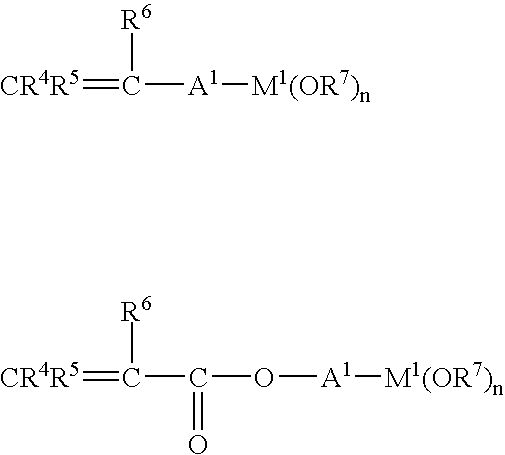Surface-treatment agent comprising inorganic/organic hybrid material
a surface treatment agent and hybrid material technology, applied in the direction of liquid repellent fibres, synthetic resin layered products, instruments, etc., can solve the problems of insufficient water repellency insufficient water repellency, etc., to achieve sufficient water repellency and durability.
- Summary
- Abstract
- Description
- Claims
- Application Information
AI Technical Summary
Benefits of technology
Problems solved by technology
Method used
Image
Examples
synthesis example 1
In a 100 mL flask equipped with a stirrer, a thermometer and a dropping funnel, 1.5 parts of heptadecafluoro-1,1,2,2-tetrahydrodecyl triethoxy silane [CF.sub.3 (CF.sub.2).sub.7 CH.sub.2 CH.sub.2 --Si(OCH.sub.2 CH.sub.3).sub.3 ] (a fluorine-containing compound) (manufactured by Shin-Etsu Chemical Co., Ltd.) and 5 parts of methyl methacrylate (MMA) were added into 15 parts of 3-methacryloxypropyl trimethoxy silane [CH.sub.2.dbd.CH(CH.sub.3)--(C.dbd.O)--O--(CH.sub.2).sub.3 Si(OCH.sub.3).sub.3 ] (TMSM) (manufactured by Shin-Etsu Chemical Co., Ltd.) and 15 parts of tetraethoxysilane [Si(OCH.sub.2 CH.sub.3).sub.4 ] (TEOS) (manufactured by Shin-Etsu Chemical Co., Ltd.). The mixture was stirred at room temperature for one hour to perform hydrolysis and condensation polymerization reactions. Resultant compound was named as "Product 1".
synthesis example 2
The same procedure as in Synthesis Example 1 was followed to give Product 2 except that 1.5 parts of perfluorooctylethyl acrylate was used instead of 1.5 parts of heptadecafluoro-1,1,2,2-tetrahydrodecyl triethoxy silane.
synthesis example 3
In a 100 mL flask equipped with a stirrer, a thermometer and a dropping funnel, 1.5 parts of heptadecafluoro-1,1,2,2-tetrahydrodecyl triethoxy silane (a fluorine-containing compound) (manufactured by Shin-Etsu Chemical Co., Ltd.) and 5 parts of polymethyl methacrylate (PMMA) were added into 30 parts of tetraethoxysilane (TEOS)(manufactured by Shin-Etsu Chemical Co., Ltd.). The mixture was stirred at room temperature for one hour to perform hydrolysis and condensation polymerization reactions. Resultant compound was named as "Product 3".
PUM
| Property | Measurement | Unit |
|---|---|---|
| Fraction | aaaaa | aaaaa |
| Fraction | aaaaa | aaaaa |
| Fraction | aaaaa | aaaaa |
Abstract
Description
Claims
Application Information
 Login to View More
Login to View More - R&D
- Intellectual Property
- Life Sciences
- Materials
- Tech Scout
- Unparalleled Data Quality
- Higher Quality Content
- 60% Fewer Hallucinations
Browse by: Latest US Patents, China's latest patents, Technical Efficacy Thesaurus, Application Domain, Technology Topic, Popular Technical Reports.
© 2025 PatSnap. All rights reserved.Legal|Privacy policy|Modern Slavery Act Transparency Statement|Sitemap|About US| Contact US: help@patsnap.com



